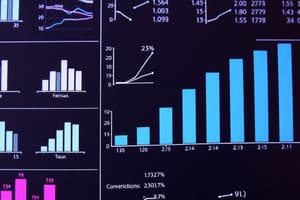Podcast
Questions and Answers
What does the Interquartile Range (IQR) measure?
What does the Interquartile Range (IQR) measure?
- The spread in the middle 50% of the data (correct)
- The average of the upper and lower quartiles
- The total spread of all data points
- The difference between the maximum and minimum values
Which of the following statements about the IQR is true?
Which of the following statements about the IQR is true?
- The IQR is affected by extreme values or outliers.
- The IQR is not influenced by outliers or extreme values. (correct)
- The IQR includes all data points in a dataset.
- The IQR is calculated as Q3 + Q1.
Which of the following correctly describes the Five Number Summary?
Which of the following correctly describes the Five Number Summary?
- It is a summary that only uses mean and standard deviation.
- It consists of the five highest data points in the dataset.
- It describes the center, spread, and shape of the data. (correct)
- It includes only the median and maximum values of the dataset.
What is the formula for calculating the Interquartile Range?
What is the formula for calculating the Interquartile Range?
Why are measures like Q1, Q3, and IQR classified as resistant measures?
Why are measures like Q1, Q3, and IQR classified as resistant measures?
What should be done when calculating a ranked position that results in a fractional half, such as 2.5?
What should be done when calculating a ranked position that results in a fractional half, such as 2.5?
In a dataset of 9 ordered numbers, what is the position of Q2 (median)?
In a dataset of 9 ordered numbers, what is the position of Q2 (median)?
How is Q1 calculated when the result of the ranked position is a whole number?
How is Q1 calculated when the result of the ranked position is a whole number?
What is the correct value for Q3 in the given data set: 11, 12, 13, 16, 16, 17, 18, 21, 22?
What is the correct value for Q3 in the given data set: 11, 12, 13, 16, 16, 17, 18, 21, 22?
What is the rule for determining the ranked position if the result is not a whole number or a fractional half?
What is the rule for determining the ranked position if the result is not a whole number or a fractional half?
What do Q1 and Q3 represent in a dataset?
What do Q1 and Q3 represent in a dataset?
Which formula will accurately determine the position of Q1 in a dataset with 9 ordered values?
Which formula will accurately determine the position of Q1 in a dataset with 9 ordered values?
What value does Q2 represent in statistical analysis?
What value does Q2 represent in statistical analysis?
According to Chebyshev's Rule, what percentage of values will fall within 2 standard deviations of the mean?
According to Chebyshev's Rule, what percentage of values will fall within 2 standard deviations of the mean?
What is the main concept of the first quartile, Q1?
What is the main concept of the first quartile, Q1?
For a given dataset, how is Q2, the second quartile, defined?
For a given dataset, how is Q2, the second quartile, defined?
If the mean Math SAT score is 500 with a standard deviation of 90, what is the range that captures at least 89% of all test scores?
If the mean Math SAT score is 500 with a standard deviation of 90, what is the range that captures at least 89% of all test scores?
How is Chebyshev's Rule useful when analyzing data variability?
How is Chebyshev's Rule useful when analyzing data variability?
What formula is used to determine the position of the third quartile, Q3?
What formula is used to determine the position of the third quartile, Q3?
What does Chebyshev's theorem imply about data regardless of its distribution?
What does Chebyshev's theorem imply about data regardless of its distribution?
How many segments are created by quartiles in a ranked dataset?
How many segments are created by quartiles in a ranked dataset?
Flashcards
Quartile Calculation
Quartile Calculation
Finding the values that divide a dataset into four equal parts (Q1, Q2, Q3).
Q1 (First Quartile)
Q1 (First Quartile)
The value below which 25% of the data points fall.
Q2 (Second Quartile)
Q2 (Second Quartile)
The median; the value below which 50% of the data points fall.
Q3 (Third Quartile)
Q3 (Third Quartile)
Signup and view all the flashcards
Ranked Position (Calculation)
Ranked Position (Calculation)
Signup and view all the flashcards
Fractional Ranked Position
Fractional Ranked Position
Signup and view all the flashcards
Non-Central Location
Non-Central Location
Signup and view all the flashcards
Median(Q2)
Median(Q2)
Signup and view all the flashcards
Interquartile Range (IQR)
Interquartile Range (IQR)
Signup and view all the flashcards
First Quartile (Q1)
First Quartile (Q1)
Signup and view all the flashcards
Third Quartile (Q3)
Third Quartile (Q3)
Signup and view all the flashcards
Five Number Summary
Five Number Summary
Signup and view all the flashcards
Resistant Measures
Resistant Measures
Signup and view all the flashcards
Chebyshev's Rule
Chebyshev's Rule
Signup and view all the flashcards
k in Chebyshev's Rule
k in Chebyshev's Rule
Signup and view all the flashcards
Quartiles
Quartiles
Signup and view all the flashcards
Q1 (First Quartile)
Q1 (First Quartile)
Signup and view all the flashcards
Q2 (Median)
Q2 (Median)
Signup and view all the flashcards
Q3 (Third Quartile)
Q3 (Third Quartile)
Signup and view all the flashcards
Finding Quartiles Position
Finding Quartiles Position
Signup and view all the flashcards
Standard Deviation
Standard Deviation
Signup and view all the flashcards
Study Notes
Numerical Descriptive Measures
- The chapter covers measures of central tendency, variation and shape in numerical data.
- It describes how to calculate descriptive summary measures for a population.
- It explains how to construct and interpret a boxplot.
- It outlines how to calculate covariance and the coefficient of correlation.
Summary Definitions
- Central tendency: The extent to which data values cluster around a typical or central value.
- Variation: The amount of dispersion or scattering of values.
- Shape: The distribution pattern of values from the lowest to the highest.
Measures of Central Tendency: The Mean
- Arithmetic mean (often just called "mean"): The most common measure, calculated by summing all values and dividing by the number of values.
- For a sample of size 'n':
- x̄ = Σxᵢ / n
- x̄ is pronounced x-bar
- xᵢ represents the ith value
- n is the sample size
Example
- Employee ages (sample of 8): 53, 32, 61, 27, 39, 44, 49, 57
- Mean age: 45.25 years
Mean for Grouped Data
- For grouped data, mean is calculated as:
- x̄ = Σ(mf) / Σf
- 'm' is the midpoint of the class
- 'f' is the frequency of the class
Example
- Number of orders received daily in 50 days:
- 10-12: 4 days
- 13-15: 12 days
- 16-18: 20 days
- 19-21: 14 days
- Mean: 16.64 orders
Measures of Central Tendency : The Median
- Median: The middle value in an ordered array (smallest to largest).
- If 'n' (number of values) is odd, the median is the middle number.
- If 'n' is even, the median is the average of the two middle numbers.
- Not affected by extreme values.
Measures of Central Tendency : Locating the Median
- Median position = (n+1)/2.
Measures of Central Tendency : The Mode
- Mode: The value that occurs most often in a data set.
- Not affected by extreme values.
- Can be used for numerical or categorical data.
- There may be multiple modes (multimodal) or no mode at all.
Measures of Variation: The Range
- Range: The difference between the largest and smallest values.
- Range = Xlargest - Xsmallest
Measures of Variation: Why the Range Can Be Misleading
- Ignores the way data is distributed.
- Sensitive to outliers (extreme values)
Measures of Variation: The Variance
- Variance: Average (approximately) of squared deviations of values from the mean.
- Sample Variance (S²) :
- S² = Σ(xᵢ - x̄)² / (n-1)
- Where:
- x̄ is the arithmetic mean
- n is the sample size
- xᵢ is the ith value of the variable X
Measures of Variation: The Standard Deviation
- Standard Deviation: The square root of the variance.
- Has the same units as the original data.
- Typically calculated to understand the variability of the sample around the mean
- Sample Standard Deviation (S) :
- S = √Σ(xᵢ - x̄)² / (n-1)
Short Cut Formula:
- S = √(Σx² - (Σx)²/n) / (n -1)
Calculating The Interquartile Range (IQR)
- The difference between the third quartile (Q3) and the first quartile (Q1).
- IQR = Q₃ - Q₁
The Five-Number Summary
- Xsmallest
- First Quartile (Q₁)
- Median (Q2)
- Third Quartile (Q3)
- Xlargest
The Boxplot:
- A graphical display of data based on the five-number summary, showing spread and skewness.
The Covariance
- Measures the strength of the linear relationship between two numerical variables (X and Y).
- Sample Covariance (Cov(X,Y)):
- Cov(X,Y) = Σ(xᵢ -X̄)(yᵢ - ȳ) / (n-1)
Coefficient of Correlation
- A unit-free measure of the linear relationship between two numerical variables (X and Y).
- Sample correlation coefficient (r):
- r = cov(X,Y) / Sₓ * Sᵧ
Features of the Coefficient of Correlation
- Always between -1 and 1.
- Closer to +1 : strong positive linear relationship.
- Closer to -1 : strong negative linear relationship.
- Closer to 0 : weak linear relationship.
Pitfalls in Numerical Descriptive Measures
- Data analysis is objective.
- Report only necessary summary measures to describe the data set.
- Data interpretation is subjective.
- Interpretations must be fair and objective.
Ethical Considerations
- Document both good and bad results in data analysis.
- Present data in a fair and objective manner.
- Avoid distorting facts through data manipulation
Chapter Summary
- Covers various numerical descriptive statistical tools and applications
Studying That Suits You
Use AI to generate personalized quizzes and flashcards to suit your learning preferences.




